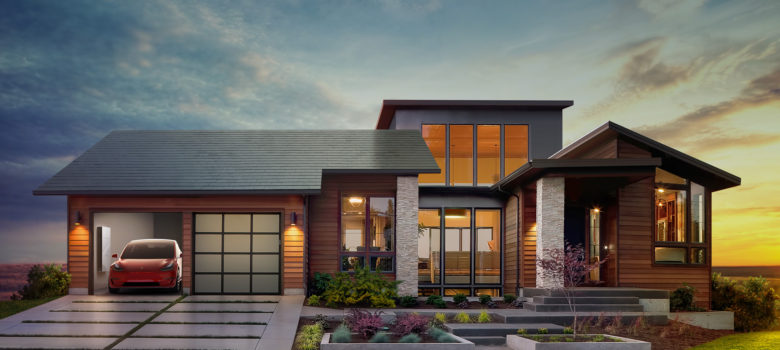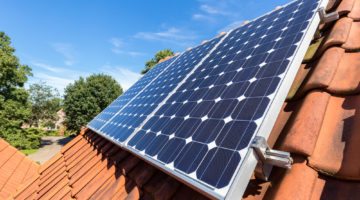
Orders are set to begin in April for Tesla’s latest offering: solar roof tiles. This is likely to boost interest in the technology and bring it to a wider commercial audience.
What are solar roof tiles?
Designed to match your existing tiles or slates, solar PV tiles – also known as solar shingles/solar slates – are basically mini solar PV panels that produce electricity from the sun. They are government-approved and therefore you can still claim the Feed-in Tariff if you decide to install these instead of more traditional solar systems.

There are currently only a handful of solar tile manufacturers, meaning there isn’t a huge choice for consumers, but we’re sure that there will soon be loads. At the moment, solar tiles are far more expensive than existing solar systems. Hopefully the price will come down once they start to be mass-produced.
How do solar tiles work?
Solar tiles work in the same way as solar PV panels, but they form part of your roof, rather than being bolted-on. The tiles are made up of photovoltaic cells and when sunlight shines on them, it creates an electric field which provides free energy to use inside your home.
The PV tiles are attached to a connection point in your attic via electrical leads. The major difference between solar tiles and solar panels is that solar tiles are designed to work as part of the roof where as solar panels are bolted on top of an existing roof.
You will need to install an inverter to convert the DC electricity generated by the tiles into AC electricity, which can be used to run your appliances. Unless you install a solar diverter or a home battery storage system, any energy you don’t use will be sent to the grid, and you will be paid for it via the Feed-in Tariff.
How much electricity you produce depends on how much sunlight the tiles are exposed to –they will generate more on a long sunny day than on a short, cloudy one. Keeping them clean will help them work at maximum efficiency, but they shouldn’t require any other maintenance unless they are damaged.
The design of older solar tiles affected their efficiency. Tesla’s new solar tiles, for instance, are designed to lay side by side, without overlapping. This is important because it means the whole tile can create energy, rather than being shaded by other tiles.
It is possible to retrofit solar PV tiles, but it will involve without ripping out the current roof tiles, so it is easier to install them when building a new home.
Cost of solar tiles
Solar tiles can cost double the price of an equivalent-sized solar panel system. Even despite this, however, they will eventually pay for themselves. The more of your own electricity you generate, the less you will need to import from the National Grid, and as a result you will save on your energy bills. These savings, coupled with Feed-in Tariff payments (which we explain below), will cover the initial installation costs after a number of years. It’s therefore worth installing solar tiles if you are planning to stay in the same property for a long time! Having solar tiles installed on your home should also add to its value if you ever come to sell it.
Provided you have your solar tiles installed by an MCS (Microgeneration Certificate Scheme) – accredited installer, you will benefit from Feed-in Tariff. However, rates are not what they were a few years ago, and won’t pay for the system alone. Feed-in Tariff payments should be thought of more as a bonus nowadays, rather than an incentive to install the technology in the first place.
The tables below show the estimated payback time for different sizes of solar panel system, and the same for solar tiles:
Solar panels
| Typical system size | Typical cost | Typical payback time |
| 1kW | £2,500 – £3,000 | >20 years |
| 2kW | £3,000 – £4,000 | 10 years |
| 3kW | £4,000 – £6,000 | <10 years |
| 4kW | £6,000 – £8,000 | <10 years |
Solar tiles
| Typical system size | Typical cost | Typical payback time |
| 1kW | £5,500 – £7,000 | 30-40 years |
| 2kW | £7,000 – £9,000 | 20-30 years |
| 3kW | £10,000 – £12,000 | 20-25 years |
| 4kW | £12,000 – £14,000 | 15-20 years |
Should I install solar tiles?
Definitely consider it if you are building a new home, want to generate your own electricity, and are willing to spend the extra money on solar tiles over solar PV for aesthetics.
Benefits of solar tiles
- They generate renewable energy!
- They blend in better than solar panels on the roof.
- They can often be installed in listed buildings and conservation areas.
Limitations of solar tiles
- More expensive than solar panels.
- Currently a small range of manufacturers and installers.
- Removing/relocating them will damage the roof.
- Unlike solar panels, they cannot be angled for optimum efficiency.












These solar tiles are a nice solution. Hopefully one day every new house will incorporate them and we can stop building these horrible big power stations!
Hi,
I’m interested in PV slates for a mid-terrace, G2 listed property in a conservation area.
Can you mail me please. Tx. Rory
Inquiry:solar tiles wanted to cover an area of approx 2qmt
mario
do solar tiles require an insulation or do they come completely insulated, since they are built as a roof alongside a generating power.
Solar tiles should be compulsory on all new build homes